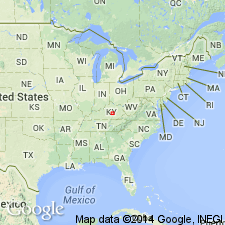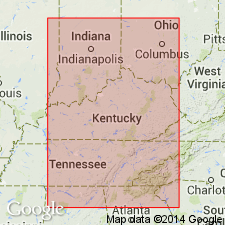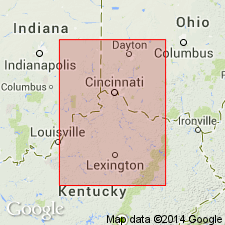
- Usage in publication:
-
- Reba Member*
- Modifications:
-
- Named
- Dominant lithology:
-
- Limestone
- AAPG geologic province:
-
- Cincinnati arch
Summary:
Named Reba Member of Ashlock Formation. "...composed of micrograined limestone at base, overlain by more or less silty, medium-grained limestone that at the top commonly grades into argillaceous limestone...Limestone in the lower 2 to 6 feet of the member is commonly in ledge-forming beds as much as a foot thick, characteristically gray to grayish green, and aphanitic and micrograined to very fine grained; this limestone generally lacks megafossils but contains sparse ostracodes and abundant cylindrical markings a few millimeters across and a few centimeters long. Most of limestone is fine to medium grained, has silty patches and partings, and is in uneven beds a few inches thick. Bedding is less distinct near the top where the limestone is more silty. The fine- to medium-grained limestone and argillaceous limestone contain abundant fossils, chiefly bryozoans and brachiopods. The member ranges from about 10 to 25 feet in thickness...". Underlain by Terrill Member; overlain by Rowland Member of Drakes Formation.
Source: GNU records (USGS DDS-6; Reston GNULEX).

- Usage in publication:
-
- Reba Member*
- Modifications:
-
- Overview
- AAPG geologic province:
-
- Cincinnati arch
Summary:
The Reba Member of the Ashlock Formation in south-central KY consists of a basal micrograined limestone overlain by medium-grained limestone that becomes silty and argillaceous near the top. The basal unit contains a few ostracodes and the rest of the unit contains brachiopods and bryozoans. Thickness is 10 to 25 feet. Overlies the Terrill Member of the Ashlock Formation and underlies the Grant Lake Limestone.
Source: GNU records (USGS DDS-6; Reston GNULEX).

- Usage in publication:
-
- Reba
- Modifications:
-
- Not used
- AAPG geologic province:
-
- Cincinnati arch
Summary:
The Cincinnatian Series is divided into five depositional sequences in this report, which correspond to lithostratigraphic units. The following stratigraphic names in KY should be abandoned as they have been applied to bodies of rock already named in downramp areas of OH and IN: Bardstown (=Lower Whitewater), Reba (=Oregonia), Stingy Creek (=Mount Auburn), Calloway Creek (=Bellevue), and Clays Ferry (=Fairview). The following units in KY, OH, and IN lump dissimilar facies and straddle sequence boundaries and therefore should be abandoned: Drakes, Ashlock, Dillsboro, Tanners Creek, and Bull Fork. Grant Lake has been defined in several different ways and consequently should be abandoned. Several units will be redefined at a later date, including the Upper Whitewater and the "Sunset" and "Saluda" of OH and IN. Formal naming of new lithostratigraphic units will follow further study.
Source: GNU records (USGS DDS-6; Reston GNULEX).
For more information, please contact Nancy Stamm, Geologic Names Committee Secretary.
Asterisk (*) indicates published by U.S. Geological Survey authors.
"No current usage" (†) implies that a name has been abandoned or has fallen into disuse. Former usage and, if known, replacement name given in parentheses ( ).
Slash (/) indicates name conflicts with nomenclatural guidelines (CSN, 1933; ACSN, 1961, 1970; NACSN, 1983, 2005, 2021). May be explained within brackets ([ ]).

